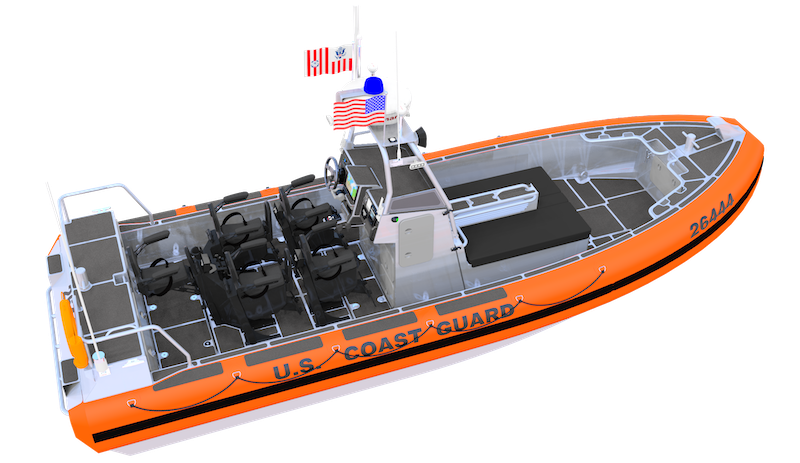Inventech Marine Solutions (IMS) has been awarded a contract by the Coast Guard to build over the horizon cutter boats (CB-OTH V). The contract is for up to 200 boats over a potential 10-year period, with a total contractual value of $103.6 million.
Bremerton, Wash.-based Inventech Marine manufactures Life Proof Boats and FAST collar systems.
The contract award resulted from a two-phase selection process. Phase one was a technical, past performance and price proposal which resulted in four competitive contracts awarded. The Coast Guard ordered a demonstration vessel from each contract that went into the phase two testing and evaluation. The demonstration period with all four selected boats was conducted over three months at multiple locations in collaboration between the Navy and Coast Guard.
The IMS hull is based on IMS’s family of 22° monohull platforms. IMS builds hulls with 8'6" beams and between 21' and 27' in length as both outboard and inboard configurations. The standard aluminum in all IMS platforms is 5086 which is also the standard required by the Coast Guard and Navy.
IMS’s demonstration model measures 25"6"x8'6", weighs 6,785 lbs., and burns 10.8 gph of fuel. The boat carries an 86-gal. fuel tank.
The IMS vessel is powered by a Cummins QSB 6.7 main engine, producing 480 hp, linked up to a HamiltonJet waterjet. The boat is also fitted with HamiltonJet HJX29 AVX Express controls. IMS found the controls to be intuitive, simple and very responsive during the set up and testing, the company said. IMS was impressed with slow speed maneuverability of a single jet utilizing the joystick.
The propulsion package gives the new model a running speed of 40 knots and a sprint speed of 30 knots.
During development and construction, IMS focused on serviceability, preventing water intrusion, deck drainage, and advanced ergonomics. The team built early conceptual structures and conducted extensive research and development testing during the material selection period to validate components and construction designs. IMS believes it was its focus on building a robust simple platform that worked well for the Coast Guard, setting its vessel apart during the Coast Guards testing and evaluation period.
IMS developed a new proprietary foam collar system which utilizes its standard material and construction processes. The new FAST collar through a unique design with progressive anhedral and reduced displacement of lower collar impact area enables the vessel to reduce slamming impacts. The design utilizes energy generated upward from the vessels’ downward moment diverting water into the anhedral tunnel area that creates lift and stabilizes the vessel. As the collar transitions aft, the shape incorporates an aft dihedral into anhedral tunnel which creates additional lift while backing down without adverse effects of low pressure.
The FAST foam collar technologies utilize brand specific materials, and construction design utilizing heat welding of polyurethane material along with a proprietary UV stable stitching thread for heavy material construction. The foam collar provides buoyancy for safety.
The Coast Guard sent IMS a post-award debriefing document that reads in part:
“The IMS boat has a number of noteworthy design features that provide mission effectiveness benefits (range that exceeds the threshold, good joystick placement, room for multiple stokes litters, removable tow post design). The contract presents supportability benefits with an engine that has an overhaul cycle that far exceeds the required minimum hours between overhaul, structure design that meets lifecycle cyclical loading criteria at 29 knots, a data logger to provide trouble shooting information, an extended radio warranty, familiarity with USCG technical data requirements, a radio enclosure, exceptional maintenance access, and improved engine mounts.
“IMS exceeded the expectations established in the Phase one evaluation delivering a boat that in many situations performed more capably than proposed. The performance of the boat during the in-water demonstration event was noteworthy in that it averaged 30 knots in SS3, the highest of any of the boats, while eliciting comments from the operators that it was the most comfortable and capable.
“The IMS boat offers desirable design and performance features with minimal shortcomings. The ability to operate comfortably at higher speeds in SS3, where the vast majority of USCG cutter boat operations take place, provides mission effectiveness benefits. Identified as the most capable boat in heavy seas for maximum speed and crew comfort and showing a remarkable ability to perform in all conditions while providing crew comfort necessary to reduce fatigue, provides mission effectiveness benefits.”
Phase 1: Merit and Risk Rating and Supported Summary:
“The proposed boat meets all the supportability requirements and offers benefits in a few key areas. The SDU provided by Hamilton Jet would greatly aid in troubleshooting casualties. The new engine mounts provide an added layer of durability in an area that the Coast Guard has suffered in the past. Familiarity with CG data standards would help develop logistics information quickly and achieve full Coast Guard support in less time. Based on the above, the Technical rating is Satisfactory.
“The production capability is controlled completely in house and is capable of exceeding the Coast Guard’s need. Familiarity with Coast Guard data standards would help develop logistics information quickly and achieve full Coast Guard support in less time. The risk rating is low.”
Phase 2: Merit and Risk Rating and Supported Summary:
“The benefits identified in Phase one were realized in the delivered boat. The production and delivered-as proposed features greatly increase the supportability of the boat. Beyond the benefits identified in the Phase 1 summary, 262356 had additional supportability features such as the deck offering nearly continuous hatches that provided ample access to every compartment while maintaining watertight integrity and the cover over the radios that was effective at preventing water intrusion to sensitive electronics. These new findings offer significant benefits to the government. In combination with benefits validated from the Phase I evaluation, the Supportability rating increases to Superior. The identified risks from Phase 1 were minimally changed. The overall risk rating for supportability remains low.”




